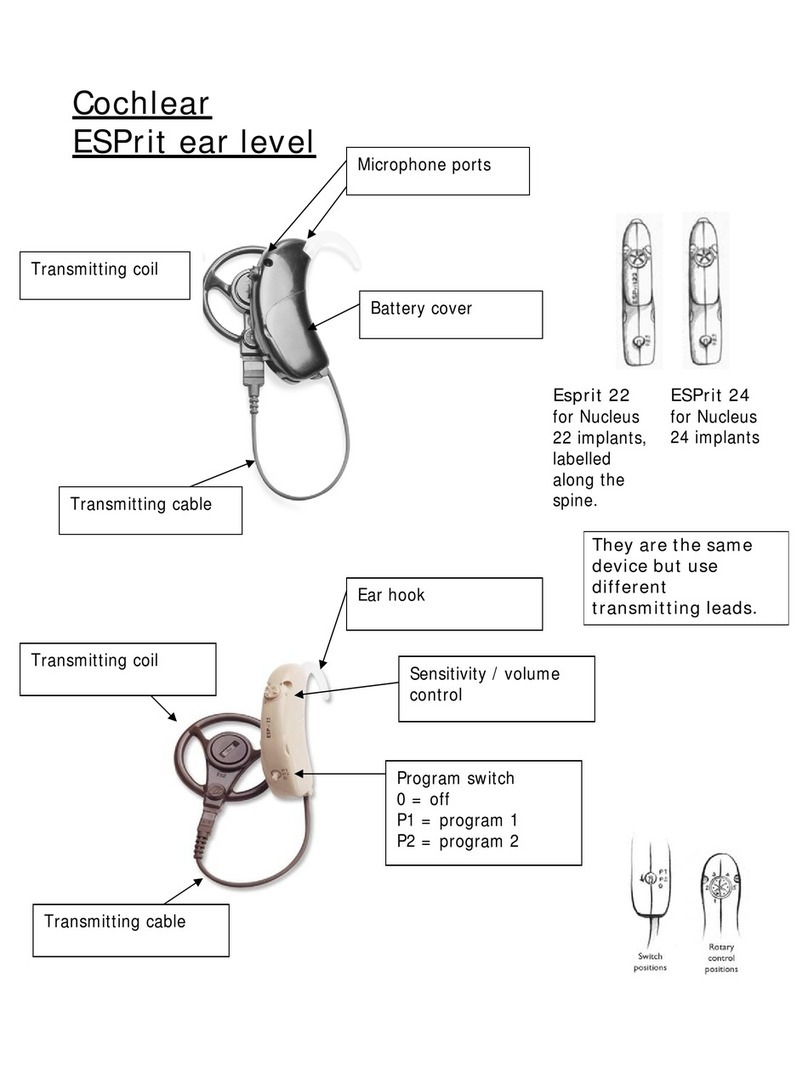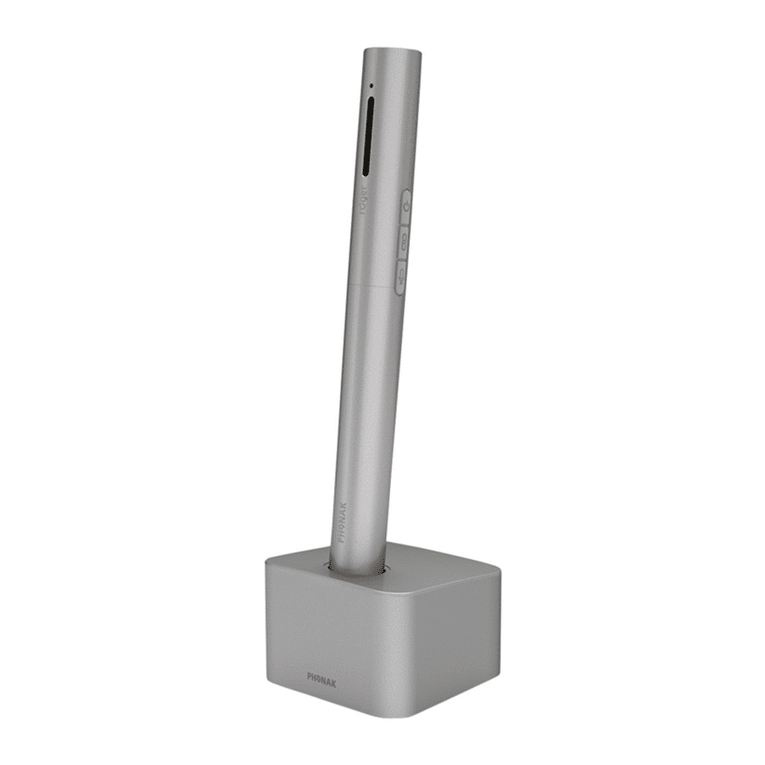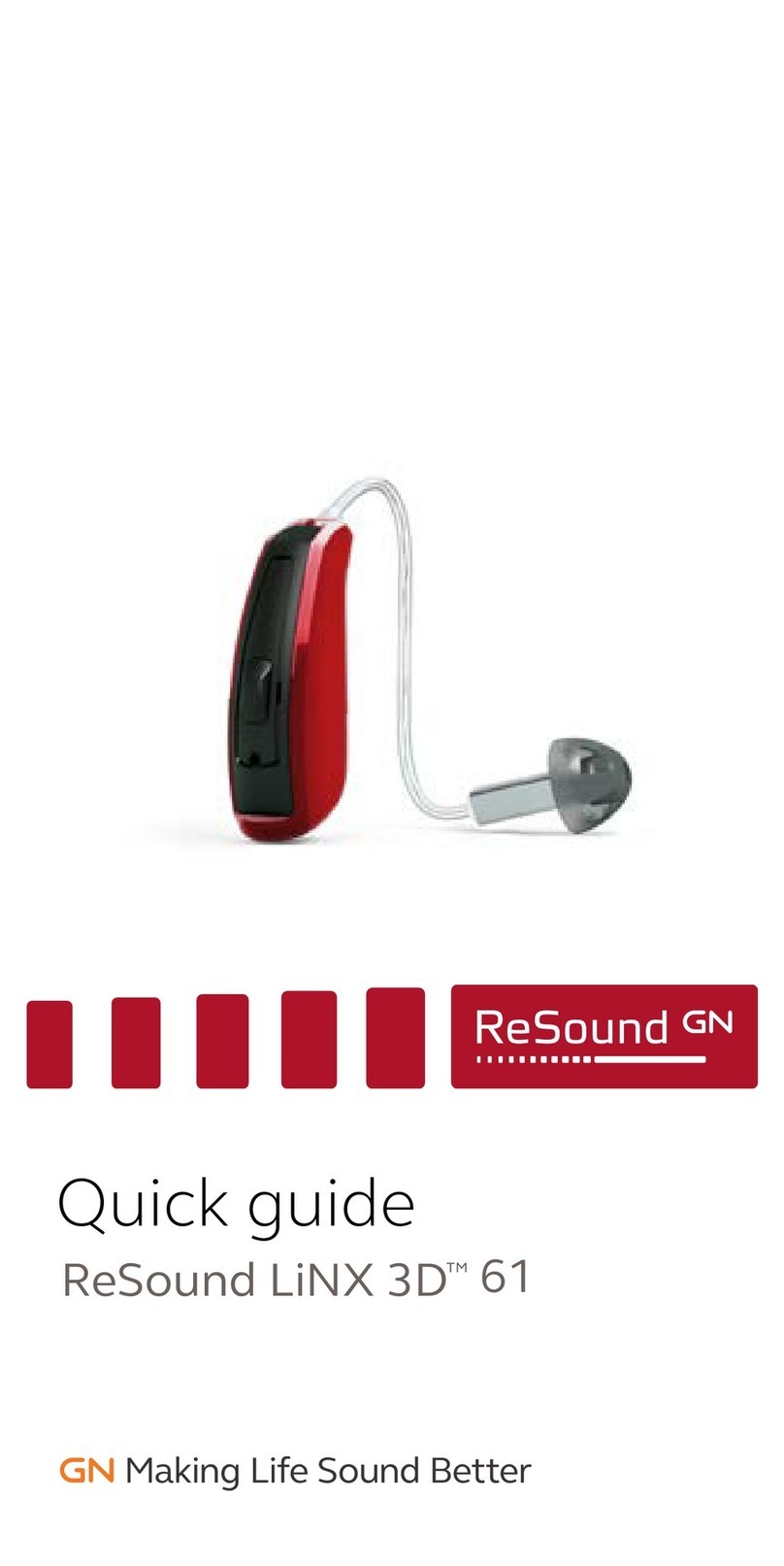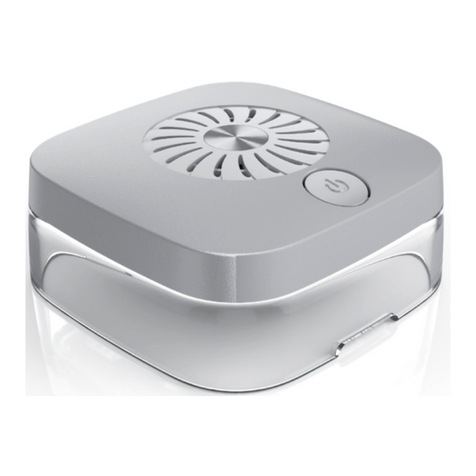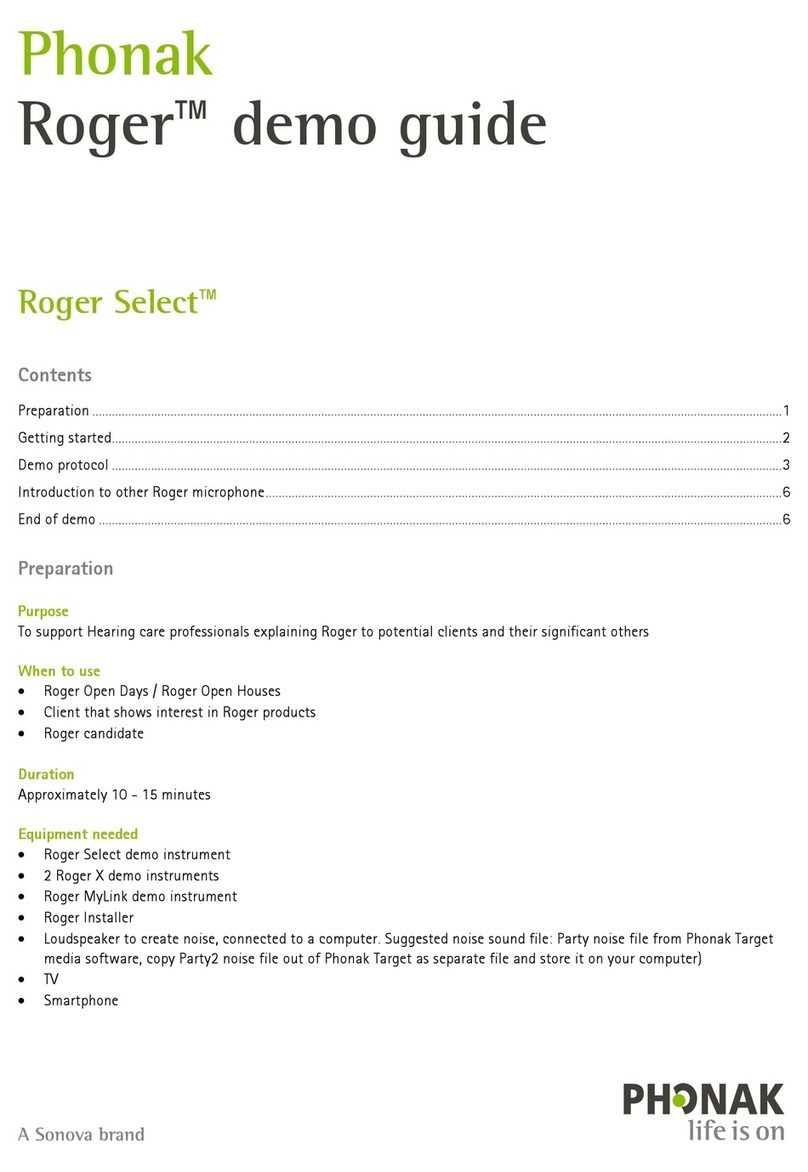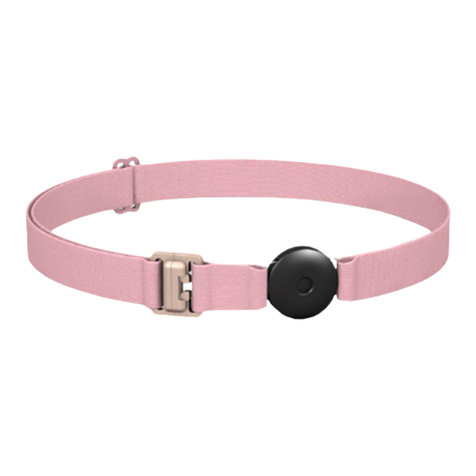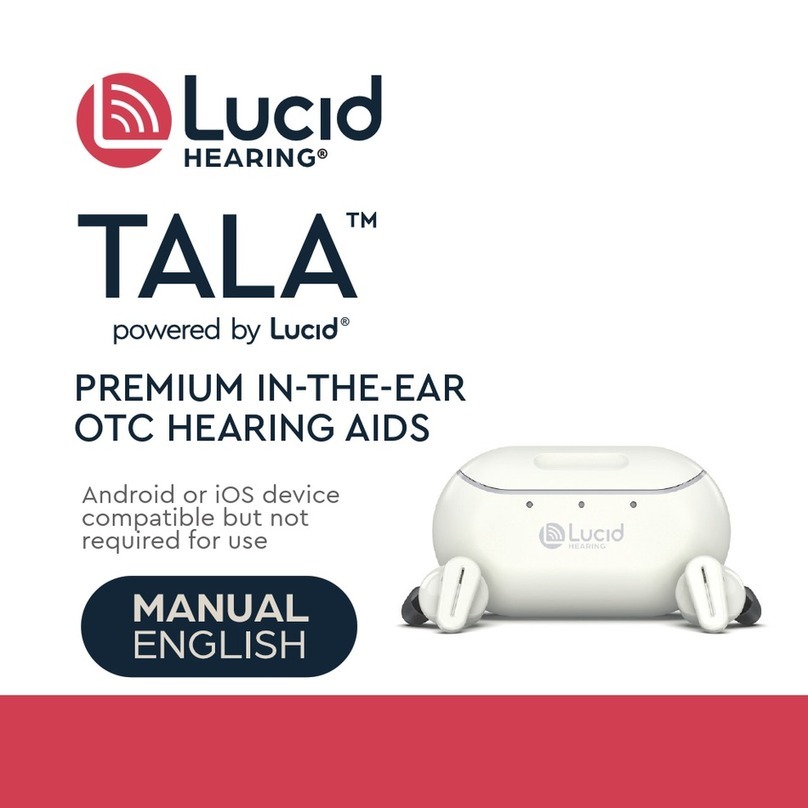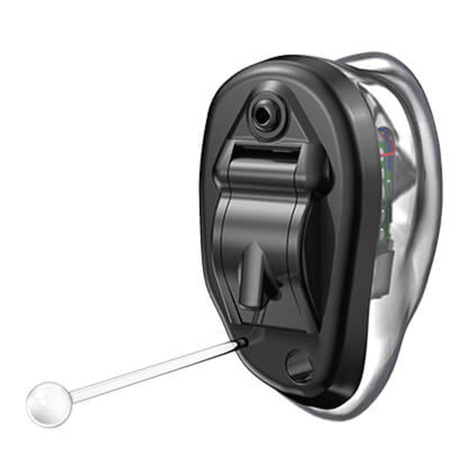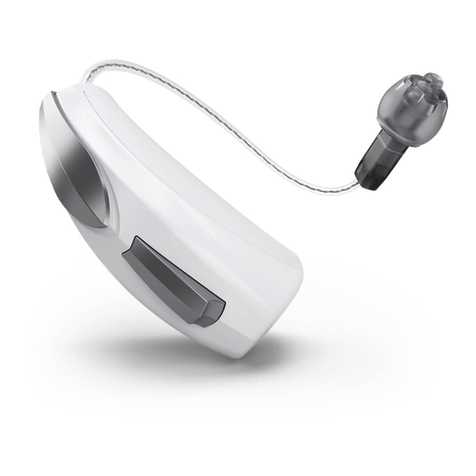AURICA Neo Classica User manual

USER MANUAL
NEO CLASSICA

3
Your Hearing Aid.........................................................................................4
Usage/Safety Tips......................................................................................5
Contraindications.........................................................................6
Care for Your Hearing Aid...........................................................................6
Battery Replacement................................................................................8
Using Neo Classica....................................................................................9
Switching ON/OFF....................................................................................10
Insertial and Removal..............................................................................10
Maintenance................................................................................12
Trimmer Controls......................................................................................13
Accessories/Cleaning solutions.............................................................13
Trouble Shooting......................................................................................14
Package.........................................................................15
Packing and Storage...............................................................................16
Reclamations....................................................................16
Disposal.............................................................................17
Warranty..............................................................................18
Contents
All rights reserved. No part of this document may be copied, repro-
duced or distributed in any form without express written permission
from AURICA Ltd.

54
Your Hearing Aid Your Hearing Aid
Read this User Manual before using AURICA Neo Classica hearing
aid. The User Manual contains the description of the device, operat-
ing principle, technical characteristics and operating instructions for
AURICA Neo Classica Hearing Aid (further - HA).
Safety Signs
Refer to User Manual/booklet
General safety sign
General prohibitory sign
IP protection
IP30
General warning sign
Your Hearing Aid is connected by the earhook to the earmold that ts com-
fortably in your ear. Your Hearing Aid may be tted to match your particular
hearing requirements. These parameters have been set by your professional
or the manufacturer and are not adjustable by the wearer. We are condent
that your listening enjoyment will be enhanced by the attention given to the
performance and appearance.
European Authorised
Representative
AURICA LTD is an EN ISO 9001 and EN ISO 13485 certied company in the
eld of development, design, manufacturing and service of hearing solutions.
This User Manual, including the specications, is an operating manual for the
AURICA Neo Classica
Hearing Aid.
Usage/Safety Tips
Neo Classica hearing aids are intended for sound amplication through the
air conduction, to compensate severe hearing loss. In Neo Classica, modern
production technologies are used – Nano coating that ensures protection of
a device from moisture and dirt; parts made by the world leading manufac-
turers; shockproof plastic body, etc. This ensures a high reliability of products
and excellent quality of sound. Before using the HA, read carefully following
the further safety instructions and important information.
Please note
• Protect your HA from impact.
• Avoid exposure to moisture (rain, sauna, shower, greenhouse etc.).
• Take your HA off when putting on cosmetics and hygiene solutions
(hairspray, cream, lotion etc.).
• If you HA got wet, don’t try drying it under high temperatures (blow dry,
microwave oven, stove, etc.).
• High temperatures will damage the device, so avoid the direct exposure to sun.
• If you are not using the device for a long time, remove the battery.
• The maintenance of the device must be done only by a specialist.
Manufacturer
Electric shock protection,
applied part BF
Electrical waste,
do not throw away
DC voltage
Catalogue number
Serial No.
Manufacture date
Notied body number
0197
Read the user’s
manual

76
Contraindications
Care for Your Hearing Aid
Hearing aid is contraindicated in case of:
• Malfunction of vestibular apparatus;
• Acute and chronic disease in outer and middle ear;
• In the rst months after cerebral meningitis and hearing improve
ment surgeries;
• Allergic intolerance to ear ttings/HA.
HA requires careful handling. The paper handling ensures the safe op-
eration of the HA. Keep your HA clean. Wipe it regularly with a soft cloth
(Pic. 1). Never wash your HA with water, cleaning solutions or other
liquids. Remove ear wax from your ears, because it can affect the func-
tionality of the HA or even break the device. If your HA was exposed to
excessive moisture, dry it with a special kit, remove the battery before
you start drying. To avoid damages, keep the HA in a special case.
Earmold care
Earmold is an important part of your HA, that’s why it’s necessary to keep
it clean.
Carefully separate the tube from the main body. Gently wash the mold with
warm, soapy water or place it in a special solution for 15-30 minutes (Pic. 2).
After the treatment, the mold has to be dried completely. If there is still mois-
ture in the tube or in the mold, use the airblowing device (Pic. 3). If the ear-
mold’s tube has lost its elasticity, become yellowish and cracked, it should be
replaced. Consult your a hearing aid specialist about this problem.
Care for your Hearing Aid
Never use any spirit solution for cleaning the earmold. Never treat
the hearing aid with the earmold cleaning solution.
pic. 1
pic. 2 pic. 3
• Hearing aids, their parts and batteries need to be kept away from
children, pets and mentally challenged people.
• Be careful with leaking batteries. The liquid inside them is
harmful for your health.
• If you have swallowed a battery, immediately seek medical attention.
Usage/Safety Tips
• Take off the device when you are being medically examined (for example
when getting X-Ray or CAT done).
• Keep the batteries separately from medications. You can easily confuse
them with pills.

98
Using Neo ClassicaBattery Replacement
Use the batteries specially intended for the HA!
pic. 4a pic. 4b
Using wrong batteries (for watch etc.) can damage the device.
In this case the warranty doesn’t cover the maintenance!
Gently swing out the battery door with your ngernail and then open it
completely (Pic. 4a), take a new battery, take the tab off and wait 1 minute
so the battery could become saturated with oxygen to increase its energy
(Pic.4b). Insert the new battery into the battery compartment with plus (+)
sign on the battery facing the same way as the (+) sign on the edge of the
battery door.
Put the battery ONLY in the door of the battery compartment.
Note: If the battery is inserted incorrectly, the door will not close.
Never press too hard close the door of the battery compartment.In
this case the warranty doesn’t cover the maintenance!
Buying a hearing aid, bear in mind that it will take some time to get used
to new sounds and sensations. How much time this process will take de-
pends on the individual peculiarities of your body, level of hearing loss, time
spent using the HA, etc. If you start feeling discomfort while using the HA ,
you need to lower the volume or turn it off and take a break.
While watching TV set the volume to a medium level. If you have a hard time
distinguishing sounds, turn the volume up using the volume comtrol. How-
ever, you should remember that turning the volume up very high doesn’t
always improve your perception of speech, but can cause sudden fatigue
and provoke the deterioration of hearing.
In a noisy environment it’s pretty hard to distinguish certain words, so don’t
be embarrassed to ask again.
The volume is adjusted with the volume control — switching from min up to
max volume (Pic. 5 — rotuting volume control: 1 — min. 4 — max; Pic.6 —
push-button volume control).
pic. 5 pic. 6
Lower amplication power and volume, or spontaneous shutdown
indicates a low battery.

1110
Switching ON/OFF Insertion and Removal
Your Hearing Aid has a three-position battery door that acts as an OFF/
ON switch and that allows access to the battery compartment. To turn the
Hearing Aid on, close the battery completely (Pic. 7b).
To turn OFF: open the battery door until it clicks, so the battery is no longer
touching the contacts (Pic. 7a).
pic. 7a pic. 7b
Insertion and Removal
Before placing the BTE onto your ear, be sure the battery is inserted
and the battery latch door is closed securely. Also make sure that
ON/OFF switch is set to OFF.
To insert, hold the earmold on the outer side near the tubing with your
thumb and forenger (Pic. 8).
The upper part of the earmold must be directed upwards. The tube must be
directed to the ear canal.
If expenencing difcultes, pull down the earlobe or pull the auride back or up
and gently insert the earmold into the ear (Pic. 9).
The directed upwards elastic part must t into place (Pic. 10).
pic. 8 pic. 9 pic. 10
Tips
• The rst days after you start using a hearing aid, you will feel it in your ear, and
there is nothing unusual in that. In a while, you will get used to it and won’t feel
any inconvenience. You will need some time to get used to wearing a hearing
aid — little by little increase the wearing time every day.
• When you only start using a hearing aid, there may be some irritation in your
ear because of a foreign object. In this case, ask for specialist advice.
• In case of any allergic reactions, ask for specialist advice.
• In case of intensive sweating and earwax formation, consult a specialist.
• For easier insertion of a hearing aid, you may gently pull your ear up to make
the ear canal wider. A hearing aid is inserted correctly if it ts tightly into the
ear and you do not feel it inside.
• Check if your hearing aid is positioned properly in the ear canal using a mirror.
The hearing aid is not intended not be seen.
It’s not nesessary to open the latch all the way
Please be gentle when pulling your ear. Don’t hurt yourself!

1312
Insertional and Removal Trimmer Controls (Option)
To properly insert the elastic part you need to:
• With the fornger try to place it under the skin crease.
• At the same time, with the other hand pull the ear up and back.
• After you have inserted the earmold, carefully place the Hearing Aid behind
the ear.
• Try not to twist the tube.
It’s not recommended to pull the earmold tubing, this way it can be
damaged, which will require repair or change of the earmold.
Maintenance
Trimmer controls are under the lid of your Hearing Aid (Pic.11), placed in the
upper part of the frame. The lid must always be closed to avoid the penetra-
tion of dust and moisture. In case the lid is lost, consult a specialist.
The specialist determines the position of trimmer controls while examining
a patient, in accordance with individual characteristics of your hearing loss
(audiogram).
pic. 11
Don’t open the lid of the trimmer compartment and change the con-
trols position in your HA by yourself.
Maintenance is necessary to avoid expensive and complicated repairs and
ensure the uninterrupted performance of the device. Free-of-charge mainte-
nance is performed during the warranty period and applies only to the parts
covered by the warranty (see “Limited Warranty”).
To obtain maintenance services, contact your hearing aid specialist (seller
of the device). The same specialist can advise you on the “post-warranty”
maintenance service.
Accessories/Cleaning solutions
Care Products:
• Cleaning kit;
• Drying container;
• Drying tablets;
• Earpiece;
• Battery (see color chart) Brown – 312, Blue – 675, Yellow – 10, Orange – 13.
You can get detailed information about the accessories and HA
cleaning solutions(and their prices) from a hearing aid specialist.
To remove, take the instrument out from behind your ear and gently pull the
earmold outwards.
Pulling down on the ear lobe may help loosen the earmold when it is being
removed.
Trimmers “LowLevelGain”
Trimmers “AGCo”
Рrogram switching button M/T

1514
Trouble Shooting Package
The device is not functioning:
—Make sure the battery is inserted correctly in the battery compartment
(see “Battery Replacement”).
—Make sure the battery door lid is closed completely.
—Make sure the battery isn’t dead.
—Make sure the earmold tubing isn’t dirty.
—Check the tube for ear wax and condensate, clean it if necessary.
If there is condensate or moisture in your hearing instrument, put it in a spe-
cial container with a drying tablet.
The sound is too quiet,static or breaking up:
—Check the volume control.
—Make sure the battery isn’t dead.
—Make sure the earmold tubing isn’t dirty.
—Make sure there isn’t any inoisture or ear wax in the tube; clean it if neces-
sary.
—If there is or moisture in your HA, put it in a special container with a dry-
ing tablet.
If all the attempts to x the problem are unsuccessful , contact your hearing
aid specialist.
The HA is whistling:
—The earmold does not sit tight enough in the ear canal. Take it out and
put it in again.
—Make sure the tubing is not damaged. If it needs to be changed, contact
a specialist.
—The earmold is deformed, it needs to be replaced with a new one. Ear wax
has built up in the ear tubing. Contact the specialist, so he cleans it up.
—Your ear canal shape has changed. You need to contact the specialist to
have a new earmold made (for custom-made earholds only).
The set consists of______________items
Customer’s signature_________________
Customer’s signature
Hearing Aid Aurica family NeoClassica
Models__________________________________________________
Complies with specication TU 9444-013-81271212-2015
and is serviceable.
Registration №___________________________________________
Serial №__________________________________________________
Q.C. Passed
№ of Item Name of Item
Quantity
1 Hearing Aid
2 Batteries
3 Earmolds
4 User Manual
5 Case
6Box

1716
Package and Storage
Package and Transportation
The Hearing Aid is packed into the plastic case and cardboard.
Technical documentation is plotted in the watertight packet and is packed
together with the housing SPO.
The Hearing Aid can be transported by any means of transport excluding
non-heated airplane sections, climatic conditions must correspond to the
national standard GOST 15150, Group 5.
Storage
For short term Hearing Aid must be stored indoors at 10…40 °C temperature,
and relative humidity must be 85 per cent at temperature of 25 °C.
For long term Hearing Aid must be stored at a warehouse of a manufacturer
EU rep. or dealer in accordance with store conditions of the national stan-
dards GOST 15150.
Disposal
Disposal of packaging - packaging components (cardboard, plas-
tics, etc.) are all classied as solid waste and can be therefore easily
disposed of with the use of recycling processes.
Before disposal is always advisable that you check the validity of the relevant
provisions of the disposal site.
Product disposal – Hearing Aid is made of various materials. Most
of them (plastic, metal, electric conductors, etc.) may be handed
over in recycling sites and can be recycled. However, other compo-
nents (electric plates, etc.) may contain hazardous substances. Therefore the
following components should be submitted in the respective centers or the
European representive of the manufacturer, where the qualied spesialists
ensure their disposal.
Before disposal is always advisable that you check the validity of the relevant
provisions of the disposal site.
Please make proper disposal!
Reclamations
For a reclamations the following form must be lled in:
Initial
date of use
Problem
occurrenced
date
Brief
description
of problem
Comments

18
Warranty
For repair (change) within the warranty term
Medical device — «Hearing Aid»
Technical conditions TU 9444-013-81271212-2015
Serial № and production data _______________________________________________
Purchasedate ______________________________________________________________
(date, signature and stamp of seller)
set in operation ____________________________________________________________
(date, signature)
accepted for warranty _____________________________________________________
Your Hearing Aid is covered with warranty. This warranty covers only manu-
facturing defects and/or materials used to make the hearing instrument to
Aurica’s design and manufacturing specications and tolerances. Your hear-
ing professional may have issued a warranty or service plan that goes be-
yond the provisions of this Warranty.
The Warranty period begins when your hearing instrument has been
shipped|sold directly to you by an authorized hearing professional and ex-
pires twenty four months later (“warranty period”).
The warranty does not cover the accessories, such as batteries, ear
tubing, earmolds, etc!
Please examine the warranty together with a hearing aid specialist and make
sure you ll out the warranty card correctly.
WARRANTY CERTIFICATE

Last revision: - December 26th 2016
Technical DATA:
Voltage 1,2 V
Current 4 mA
Power consumption:
performance mode – 4 mA, off mode – 0 mA
IP30
«Aurica» Ltd,
Russia, 300026 Tula,
Ryazanskaya street 4.
T e l . : + 7 4 8 7 2 2 3 - 1 0 - 6 0
E-mail: [email protected],
www.aurica.ru
ONKOCET Ltd.,
Kutuzovova 4, 90102
Pezinok, Slovakia
Tel.: +421 2 4464-09-77
Email: [email protected]
www.onkocet.eu
0197
Table of contents
Other AURICA Hearing Aid manuals




